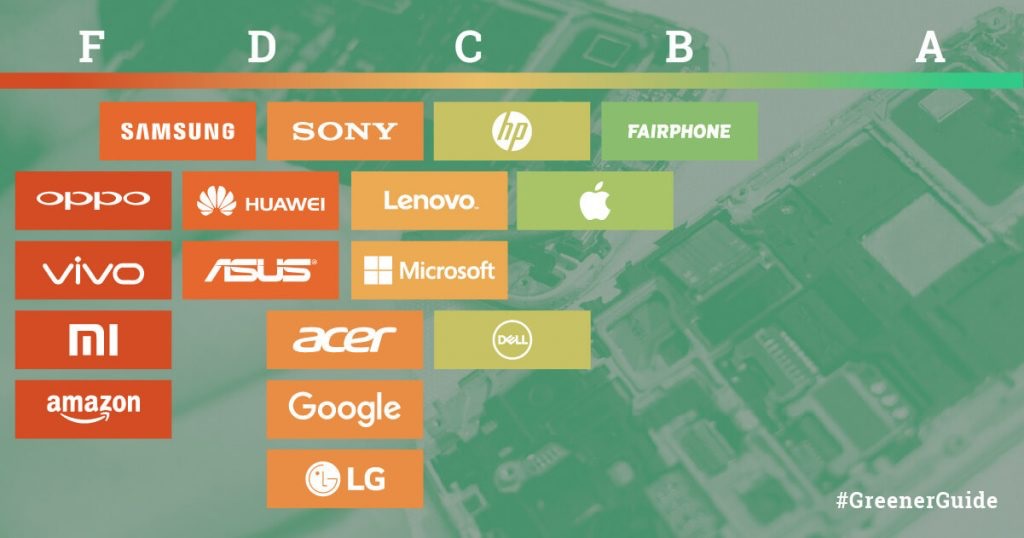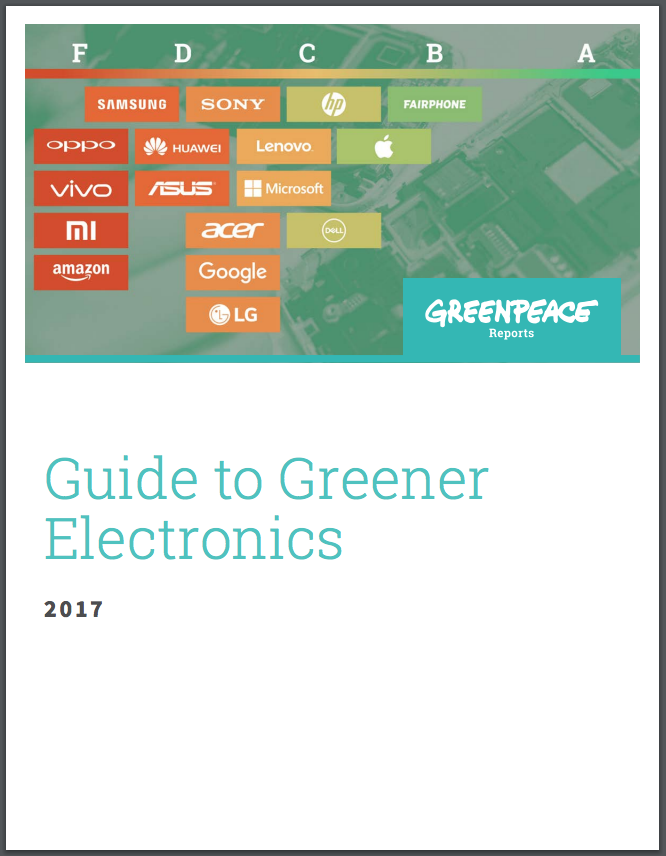
“With the relaunch of the Guide, we have focused on measuring elimination of hazardous chemicals from both the product itself and manufacturing.”
Samsung Trails Behind Apple in New
Greenpeace Guide to Greener Electronics
Average Grade Across 17 Companies Is D+,
Indicating Long Way to Go Toward Sustainable IT
 San Francisco, October 17, 2017 -The 2017 Guide to Greener Electronics (the Guide) was released today by Greenpeace USA, with rankings of seventeen of the world’s leading consumer electronics companies on sustainable manufacturing and design of IT products.
San Francisco, October 17, 2017 -The 2017 Guide to Greener Electronics (the Guide) was released today by Greenpeace USA, with rankings of seventeen of the world’s leading consumer electronics companies on sustainable manufacturing and design of IT products.
Companies were evaluated based on their transparency, commitment, performance and advocacy efforts in three critical areas: reduction of greenhouse gases through renewable energy; use of recycled materials; and elimination of hazardous chemicals.
“Tech companies claim to be at the forefront of innovation, but their supply chains are stuck in the Industrial Age. We know they can change. Rather than fueling climate change, IT companies need to show the way forward, just like Google and Apple have done with data centers run on renewables,” said Gary Cook, Senior IT Campaigner at Greenpeace USA.
The average grade across the 17 companies evaluated in the Guide was a D+, demonstrating that the sector as a whole has work to do to resolve supply chain impacts and improve product design. Fairphone, based in the Netherlands, scored best overall with a B, followed by Apple with a B-. Dell and HP follow Apple and Fairphone with a C+, while eleven companies, including Samsung, Huawei and Amazon, fall in the D and F range. The full list of rankings can be found here.
Despite its central position as both the largest manufacturer of smartphones and one of the largest suppliers of displays, Samsung’s manufacturing system relies heavily on fossil fuels. The company used more than 16,000 GWh of energy in 2016, with just 1% coming from renewables, for example.
Demand for consumer electronics continues to climb, with nearly 2 billion devices sold in 2016 alone. This drives demand for both finite mined materials and dirty energy. Meanwhile, e-waste is growing, due in part to the short lifespans of devices. The UN has estimated that e-waste globally will surpass 65 million tons in 2017–enough to bury San Francisco to 14 feet.
Key findings of the 2017 Guide to Greener Electronics include:
- Supply chain driving demand for dirty energy: Up to 80% of the carbon footprint of electronic devices occurs during manufacturing. While Google, Apple and other internet companies are making progress transitioning their data centers to renewable energy, nearly all of the companies in the Guide have yet to address the rapidly growing carbon footprint and dependence on dirty energy in their supply chains. Apple is the only company thus far that has committed to 100% renewable power for its supply chain.
- Planned obsolescence as design feature: Apple, Microsoft, and Samsung are among the companies moving in the wrong direction on sustainable product design – many of their latest products are difficult to repair or upgrade. HP, Dell, and Fairphone are the notable exceptions to this trend, producing a growing number of products that are repairable and upgradable.
- Poor supply chain transparency: Despite representing the majority of the environmental footprint for most electronic manufacturers, most companies publish little information on their suppliers, keeping their environmental footprint of their supply chain hidden from view. Of the 17 companies evaluated in the Guide, less than one third publishes a basic list of suppliers, keeping their supply chain hidden from view.
- Lack of transparency and monitoring of workplace chemicals: To protect worker health and safety, all companies need to identify and eliminate hazardous chemicals used in the production of their products, and improve worker health and safety due diligence. Apple, Dell, Google, HP, and Microsoft are the only companies in the Guide that publish their list of substances that must be restricted in the manufacturing of their devices (MRSL), including known hazards benzene, n-hexane, and toluene.
“It is clear the impacts of the linear take-make-waste business model employed by device manufacturers extend beyond the concerns of e-waste. We need to see greater ambition, more transparency, and follow-through from companies to address the environmental impacts of their enormous supply chains. The current model cannot be maintained,” said Cook.
Greenpeace is challenging the IT sector to take responsibility for its rapidly increasing footprint on the planet by:
- Shifting their supply chains to be renewably powered;
- Reducing the cycle of constant consumption of more minerals and other resources by designing long lasting products that use more recycled materials, and;
- Detox their products and their supply chain by finding alternatives to hazardous chemicals.



